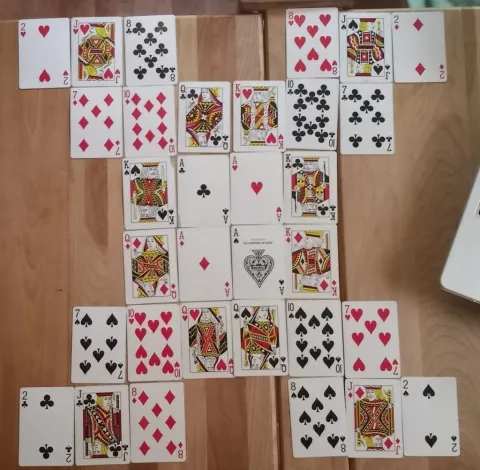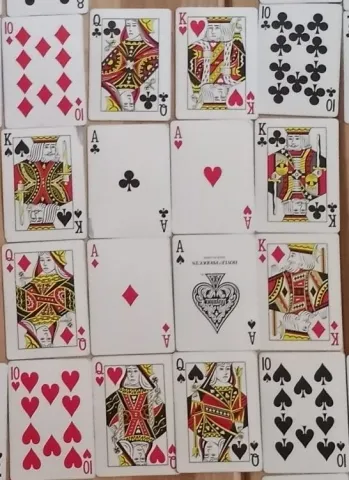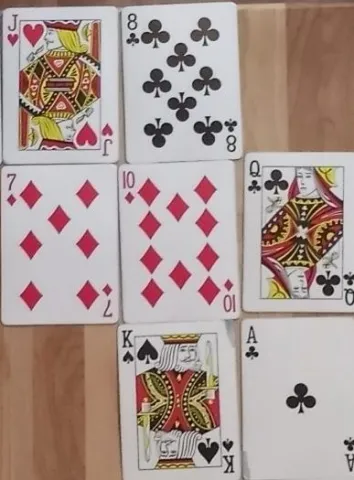A couple of months ago, I wrote a Mastodon thread about one of my favorite creative writing exercises known as Cartes Noires or “Black Cards” in English. The response from writers on the Fediverse was really positive. However, I found trying to explain some of the finer details of this constraint somewhat challenging with the character limit. So, that’s why we’re here! In this post, I wanted to do a write-up in a blog format so I could include more details, more photos, and a better resource for future writers.
What Is Cartes Noires?
Cartes Noires is a constrained writing exercise to help authors craft the plot for a mystery novel in about 30 minutes. To do it, you only need a standard deck of playing cards and your imagination. By setting a couple of rules about what certain cards mean, it is possible to make a fairly elaborate, novel-length whodunnit story on the fly.
There are a ton of different ways that someone could modify this basic novel writing framework to suit their individual needs or genres. The idea of using playing cards for story writing shows up in other narrative disciplines other than novel writing. In that regard, there are related farmeworks out there for other genres.
For instance, there is a similar system using a deck of cards called The Quiet Year, which is adapted for fantasy world building in the TTRPG world. What makes Cartes Noires unique is its use of laying cards out in a specific arrangement with certain positions meaning certain relationships between characters, or types of clues in the story. This makes the exercise sort of cousin of tarot cards.
Some of the commenters from my original thread openly wondered if a tarot deck could work instead of playing cards. Even if it couldn’t (due to that pesky fifth suit), this system certainly feels like murder divination. So, let’s light a few white spell candles beneath an alter to Agatha Christie and get started.
Who Created Cartes Noires?
The Oulipo is credited with the creation of this and many other creative writing exercises like it. The Oulipo is a group of predominantly French writers and mathematicians who sought to create a catalog of constrained writing prompts and creative writing exercises. The writing constraints they created are designed to sharpen the skills of new and old writers alike, and they often feature a mathematical twist. Many giants of postmodern literature called themselves members at one time or another during their careers. Alums include Georges Perec, Italo Calvino, François Le Lionnais, and Raymond Queneau. The word “Oulipo” is a portmanteau that stands for Ouvroir de littérature potentielle, roughly translated as “the workshop for potential literature.”
Oulipo & Detective Fiction
To be more specific, the Cartes Noires system was developed by an offshoot group inspired by the Oulipo, called the Oulipopo. The extra “po” stands for the word policière, which in this case makes the translated group name read as “the workshop for potential detective literature.” Altogether, that means that the Oulipopo was focused making constrained writing prompts for mystery novels and detective fiction.
Cartes Noires was one of the creative writing exercises that came out of this group. The Oulipopo and the Oulipo saw constraints like this as a way of forcing a writer to adhere to a set of rules to help them sharpen, focus, or otherwise enhance their writing by forcing them to think outside of the box. A box, in fact, that the author helped create in the first place!
Setup & Example Exercise

Here is an example image of what Cartes Noires might look like when laid out on a table. Note that specific cards are laid out in a certain order. I will describe what each of these cards, suits, and positions means in detail.
To get started you will need a deck of playing cards, but not the whole deck.
You Will Need:
- Face Cards
- Aces
- 10’s
- 8’s
- 7’s
Note that the image I posted on this tutorial also has 2’s. This is a non-standard addition that I used to customize the constraint to my own needs, but more on that later. For now, know that you are free to adapt this system to your particular needs, or even just as a way to challenge yourself.
What The Cards Mean
- Kings and Queens represent the main suspects in your case. One of these will be your victim. You’re free to choose the victim based on the plot suggested by the arrangement of the cards and the kind of stories you like to write.
- Jacks represent witnesses.
- Aces represent powerful motives for a suspect to commit the crime. Each suit represents a different kind of motive. Note that aces can only implicate a single suspect at a time based on where it is placed in the grid. So, even though an Ace of Spades is touching both the King of Diamonds and the Queen of Spades, the Ace of Spades only directly implicates the Queen of Spades.
- The ace in the upper right implicates the suspect on its right.
- The ace in the bottom right implicates the suspect directly below.
- The ace in the bottom left implicates the suspect on its left.
- The ace in the upper left implicates the suspect directly above.
- 10’s represent a secret relationship between the two face cards they are touching. The suit of the card suggests the nature of the relationship.
- 7’s represent circumstantial evidence whether it be, hearsay or some other form of inference.
- 8’s represent physical evidence like blood, footprints, the murder weapon, etc.
Each type of card from this list is used to represent a different plot element in your story.
On Red Herrings
In my customized version of the constraint, I used 2’s to represent red herrings that I want to plant during the story. This could be something like a popular (but incorrect) reading of what certain evidence may mean concerning the case or even something as simple as a witness who lies to the detective. Specifically, I added these cards as a reminder to myself that there should be a plot point baked into the story that allows for a misinterpretation of the facts as they relate to specific suspects.
What The Suits Mean
The card suits represent motives or character traits in a general sense. Every card’s meaning, character, or relevance to the plot can be augmented by the suit it carries. For instance, an 8 of hearts represents physical evidence of a passionate nature. So that may show up in your story as a lipstick stain on the victim’s collar.
Likewise, the King of Spades might be a mob boss or a corrupt politician.
- Spades represent misdemeanors and illegal, corrupt, or simply dubious activities.
- Clubs represent financial interests, money, greed, venality, envy, and avarice.
- Hearts represent passion, love, hatred, jealousy, and vengeance.
- Diamonds represent ambition, betrayal, and power.
Keep these suits in mind when you are laying out your cards. It will help you figure out how your suspects are connected, why they may have wanted to commit a crime, and what their backgrounds are. Get creative here!
Laying Out The Cards
To begin with, this constrained writing system is always a little more fun if you give the deck a good shuffle. That way, you can be surprised by the unexpected combinations of cards and positions. Of course, you can “fine-tune” the story by moving a few cards around to fit a particular reading.
Start With The Aces
Lay your aces out in a 2×2 grid. Remember that the placement of each ace implicates a certain suspect. Refer to the suit list above for details.

Arrange The Royals & 10’s
Place face cards directly above, below, left, and right of the Aces. In the corners, place the 10’s.


Complete The Evidence Squares
The 10’s you placed in the last step make up one corner of what I call the “Evidence Squares”. Adjacent to each ten place a single 7, and an 8. Diagonal to the 10, place a Jack.

Add Your Own Creative Touch (Optional)
Now you have a choice. As I’ve said before, you could jump ahead and decipher what your cards may mean. Or you can rearrange them, or add more cards to the base structure to suggest other requirements for your plot.
Interpreting The Cards
Now for the fun part.
Your final arrangement should give you some examples of how your prime suspects are related, why they wanted the victim dead, who that victim knew, and the kinds of evidence that the killer may (or may not) have left behind. Plus, your arrangement may suggest any number of red herrings, plausible (but ultimately, wrong) motives to kill the victim, and even some general ideas about how your detective could learn information by talking to suspects and gathering clues.
A Sample Card Reading
Using my example image once again, here are some plot points the cards may suggest:
- The King of Hearts is a writer and our victim. He appears to have been murdered in a crime of passion (AH).
- One suspect is a rich movie director (KC) who was being blackmailed by the victim (via 10C).
- Other suspects include an Ex-Lover (QH) who wanted to kill the victim because he had ruined her career, and King of Diamonds, a long-lost friend of the victim who may have murdered him over a disagreement about a crime they committed together as kids.
A note on interpreting Jacks. It helps to limit the scope of these cards to the two suspects they are closest to. Let’s refer to my example image again. The 8 of Clubs and the 7 of Diamonds in the upper left-hand corner are logically related to the Queen of Clubs and the King of Spades. This means that this witness has specific information about one or both of the suspects in this corner of the grid.
Summary
Speaking for myself, writing constraints like Cartes Noires get me really inspired to write. They a true challenge to pull off and work into a story without anyone noticing, but I find they motivate me to write in the same way I feel motivated to solve a jigsaw puzzle sitting on a table. Constrained writing exercises force me to consider every step in my writing. I have to show up for every line I write. I’ve said it before, it’s really easy to get in a writing rut.
As writers, we so often delude ourselves into thinking we have creative control over every aspect of our writing. We tell ourselves we can write anything we want. However, we fall short of that promise when we reach for the same tools, words, and plots time and time again.
I believe keeping creative writing exercises like this on hand can make us better writers. More than that, I think regular practice can also make us better judges of craft.
If you end up writing a piece of writing using Cartes Noires, I’d love to read it! Please feel free to share your experiences and let me know what it was like for you in your practice.



Comments